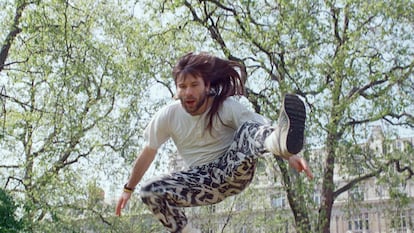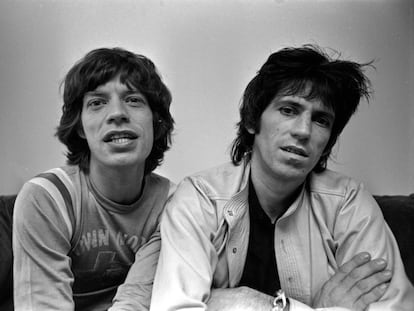The singer was the traitor: 30 years of ‘Fear of the Dark’, the album that nearly killed Iron Maiden
The album with which vocalist Bruce Dickinson said goodbye to the band (only to return in 1999) is turning three decades old

Things were looking bad for Iron Maiden in the early 1990s. British heavy metal’s emblematic band had just experienced a memorable decade, with a handful of albums that became classics as soon as they were released, and the noise of millions of enthusiastic fans overcame the remarkable media and advertising silence, if not censorship, especially from those who saw them as dangerous Satanists. The genre, however, was losing commercial traction in the face of the advance of alternative rock sounds, specifically grunge, which dominated the scene following the release of Nirvana’s Nevermind in September 1991.
The band, founded by bassist Steve Harris in 1975, was seeking to correct the first significant setback of its career: the album No Prayer for the Dying (1990) had failed to impress both critics and fans. To set things right, the band had to try to square the circle by adapting to the times while also remaining faithful to its principles. It was not the first time that Iron Maiden had gone through this predicament; in the beginning, Harris had stood firm and defied the voices advising the band to ride the punk wave at the end of the 1970s, following the success of Sex Pistols and The Clash. But this time, the voices accusing the band of being too “conservative” musically came from within. The disagreements with singer Bruce Dickinson, the band’s charismatic lead singer since The Number of the Beast (1982), were increasingly evident in both interviews and artistic output.
Dickinson, the loose cannon
In 1990, Dickinson had already briefly left the band to release a solo album, Tattooed Millionaire, which had a very different sound from Iron Maiden. Publicly, Dickinson proclaimed his admiration for the latest works of artists like Alice in Chains and Sting, representations of the “real” and “sincere” spirit around which he said he wanted to orient himself.

Revolving around that difference of creative opinion, Iron Maiden released Fear of the Dark, its ninth studio album, on May 12, 1992. The album featured several major lineup changes. The first difference was that, for the first time, Derek Riggs—the illustrator who created Eddie, the band’s famous mascot—had not done the cover. Instead, the band opted for a drawing by Melvin Grant (who would be a frequent collaborator of the band thereafter), who transformed Iron Maiden’s signature character into a sort of vampiric creature, crouched on a tree branch with a full moon in the background, in an attempt to “update Eddie for the 90s,″ as manager Rod Smallwood confided to biographer Mick Wall in the book Iron Maiden: Run to the Hills (1998).
Another important change took place within the lineup: guitarist Adrian Smith, present since the second album, left the band and was replaced by Janick Gers, a musician friend of Dickinson’s who had played on his solo album. Rebalancing powers, Steve Harris (the band’s bassist and founder) assumed the role of producer, a position he continued to hold from then on.
The album was a best-seller, and Iron Maiden reached number 1 on the charts for the third time in the UK (they had already done so with The Number of the Beast and with Seventh Son of a Seventh Son in 1988), although the critics were somewhat less enthusiastic and considered it a slight but insufficient improvement. “Despite its iconic title track and a handful of inspired moments, Fear of the Dark is one of the weakest albums in Iron Maiden’s incredible first stage,” says music journalist Joe Daly, a contributor to specialist magazines like Metal Hammer and Classic Rock. “You have to congratulate them for being open to changing with the times, but they made the wrong changes. They seemed to want to jump from their typical battle and fantasy themes to social discourse lyrics, such as the anti-war Afraid to Shoot Strangers [inspired by the recent Gulf War] and commentary on the AIDS epidemic [Fear Is the Key] and soccer hooliganism [Weekend Warriors].”

“On previous albums, we used to hide ideas through allegorical concepts and the use of mythology or legends as a way to mask our true personal feelings. This time, we showed them and gave our music a new dimension,” Steve Harris proudly told the French Hard Force Magazine. Dickinson didn’t see it that way. Despite his important contributions to Fear of the Dark (songs like Wasting Love and Be Quick or Be Dead, both co-written with his colleague Gers, would not have been out of place on Tattooed Millionaire), he expressly accused Harris of using fantastic imagery to repress his emotions. In a famous interview with the British rock media outlet Kerrang!, the singer spoke out against the subtle style of Harris’s compositions: “At first, all that allegorical stuff was very intriguing, but why doesn’t he say what he wants to say? If it had been up to me, Maiden would have always expressed feelings and opinions much more.” The interview would be one of the last Dickinson gave as the band’s lead singer at that stage, which he ended in August 1993.
“Fuck’ im, let’s get a new singer!”
The Kerrang! interview was not only notable for Dickinson’s statements. The story, written after the singer had already publicly announced that he would leave Iron Maiden at the end of the band’s current tour, best reflected the bad vibes among the band members at the time. Both Harris and the drummer, Nicko McBrain, accused the lead singer of a lack of commitment for performing poorly at the concerts for which they were still under contract, and they expressed their indignation that Dickinson had made it known that he was leaving, which transformed the Fear of the Dark shows into a farewell tour.
Some media outlets even suggested that it was a calculated move to boost disappointing ticket sales. But McBrain was undoubtedly the harshest. “Fuck ‘im, let’s get a new singer! My father, rest his soul, said to me once, ‘Son, if anyone ever shits on the McBrain name, they’ll only do it the one time,” he declared, prompting journalist Jason Arnöpp to ask him whether Dickinson was “shitting on Iron Maiden.” He retorted: “Sure he did! He’s fucking leaving the band, you dip-shit! He’s said, Fuck you, I’m off’ It that ain’t shitting on you, then what the fuck is?”
The frontman tried to avoid controversy by claiming that the reporter had gotten McBrain drunk to get those statements; at another point in the interview, McBrain ventured that Dickinson had been visiting L.A. and some “fucking wankers” had convinced him to “leave that bunch of fucking has-beens behind.”
“Journalists...everybody knows what they’re like!” Dickinson told Hard Rock Magazine months later, and claiming that the relationship between the band members was very good. But years later, he would confide in biographer Mick Wall about the “bad blood” that existed on stage at the time.

The double world tour following the release of Fear of the Dark took place with few hitches, except for the banning of their concert in Chile (after the Church pressured the government over the satanic references in the band’s lyrics) As Harris also told Kerrang!, a Spanish fan offered to “assassinate” the “traitor Bruce” on his way across the peninsula. Between 1992 and 1993, the band played 112 concerts around the world.
Slaves to the stage
The band’s concert schedule was another source of friction. In this regard, Iron Maiden set their record in the mid-1980s; it had 187 dates on the Powerslave album tour from August 9, 1984 through July 5, 1985, averaging nearly four concerts a week for almost a year in Europe, America, Japan and Australia. “On the last leg, some nights I got to thinking: why is this so much like slave labor?” stated Dickinson. What they needed was a two-year hiatus to rest and recharge their batteries, opined journalist and critic Joe Daly. Despite the attempts to reinvent the group and frustration with the results, which the singer also expressed in Fear of the Dark, Daly believes that changing the formula was unnecessary: “The Iron Maiden of the 1980s had a run like no other band in the history of rock or metal, with an unparalleled number of classic albums in just eight years. They established themselves as the dominant metal band of their era, staying true to their ethos and sound even as trends changed.”
Neither Iron Maiden nor Bruce Dickinson had much luck when they went their separate ways. Dickinson teamed up with Adrian Smith, another ex-Maiden member, but even that effort failed to attract much mainstream interest in his solo project. Meanwhile, the British band signed singer Blaze Bailey, who sang on two of their most unpopular and commercially unsuccessful albums (although there were some defenders among the group’s fans). The band ended up firing Bailey after having to cancel concerts because of his voice problems, which stemmed from being forced to sing outside his natural register without sufficient time to recover.
To the delight of fans, the opposing parties made their peace in 1999 and, in the process, brought Smith back, kept his replacement Janick Gers, and completed the three-guitar lineup with Dave Murray, which has characterized the sound of Iron Maiden since then. Thus, the band inaugurated a new era with the acclaimed Brave New World (2001). Unlike Fear of the Dark, where they did not share any credits, Dickinson and Harris collaborated on four out of the 10 compositions on that album. “They re-emerged as one of the most vital voices in metal, which is no mean feat when you consider the number of bands and sub-genres that have appeared in the last 20 years,” claims Joe Daly. “The fact that Maiden continues to release albums like The Book Of Souls [2015] and Senjutsu [2021] proves that they are one of the most important bands in modern music, not just heavy metal.”
Tu suscripción se está usando en otro dispositivo
¿Quieres añadir otro usuario a tu suscripción?
Si continúas leyendo en este dispositivo, no se podrá leer en el otro.
FlechaTu suscripción se está usando en otro dispositivo y solo puedes acceder a EL PAÍS desde un dispositivo a la vez.
Si quieres compartir tu cuenta, cambia tu suscripción a la modalidad Premium, así podrás añadir otro usuario. Cada uno accederá con su propia cuenta de email, lo que os permitirá personalizar vuestra experiencia en EL PAÍS.
¿Tienes una suscripción de empresa? Accede aquí para contratar más cuentas.
En el caso de no saber quién está usando tu cuenta, te recomendamos cambiar tu contraseña aquí.
Si decides continuar compartiendo tu cuenta, este mensaje se mostrará en tu dispositivo y en el de la otra persona que está usando tu cuenta de forma indefinida, afectando a tu experiencia de lectura. Puedes consultar aquí los términos y condiciones de la suscripción digital.
More information
Últimas noticias
Welcome to the post-religion era: The idea of Christianity as the absolute truth has become obsolete
‘I thought you would like it’: The risky sexual practice popularized by TV shows and TikTok
The digitalization of tourism: ‘They promise experiences and gave us the worst possible one’
Mexican peso defies uncertainty with forecasts of a new period of stability in 2026
Most viewed
- Sinaloa Cartel war is taking its toll on Los Chapitos
- Reinhard Genzel, Nobel laureate in physics: ‘One-minute videos will never give you the truth’
- Oona Chaplin: ‘I told James Cameron that I was living in a treehouse and starting a permaculture project with a friend’
- Why the price of coffee has skyrocketed: from Brazilian plantations to specialty coffee houses
- Silver prices are going crazy: This is what’s fueling the rally










































